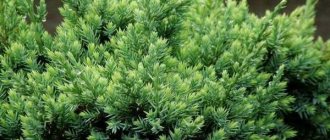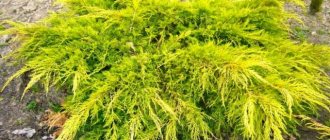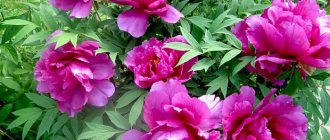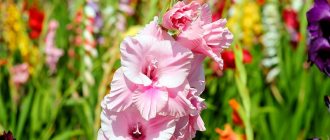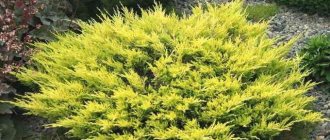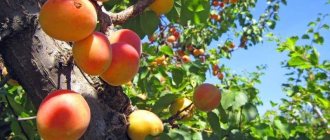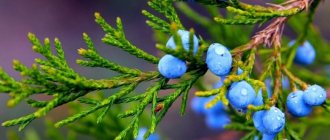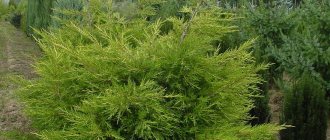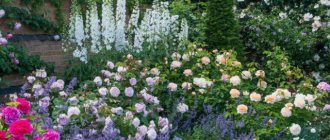Description
Junipers virginiana are perennial evergreen trees or shrubs belonging to the Cypress family.
There are about 70 representatives of this species in total. Juniperus virginiana is widespread throughout North America. Most often these are monoecious trees reaching a height of 30 meters. The diameter of the trunk reaches 150 centimeters at this height. The needles are dark green, scaly, very small (up to 2 millimeters). The cone-berries also look decorative: they ripen in the first year and remain on the branches for a long time. Ripe fruits are dark, almost black, with a bluish tinge. Depending on the variety, the crown takes the shape of a cone or an outstretched funnel. Like all junipers, this representative is a long-liver, with an average age of 500 years. It was described as being cultivated in English gardens as early as 1660.
Description of the bush
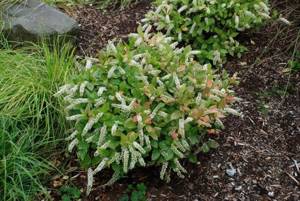
Itea virginica is an erect, low plant. In areas where harsh winters prevail, it can reach a height of no more than half a meter. In southern areas with a warm, humid climate, two- or three-meter varieties grow. The shrub is distinguished by rich and saturated foliage, and arched long branches form a wide, beautiful crown. The branching of Itea resembles the structure of Spira. The leaves have a dark green color and an elongated oval shape with jagged edges. The leaves are approximately 10 cm long. The largest of them grow on the main adult shoots and create an attractive background for spectacular flowering.
As autumn approaches, the shrub's vegetation turns a brighter purple color, making it stand out from other plants in the garden. Sometimes it is for this reason that some gardeners like to experiment and thus create unique autumn compositions.
During the flowering period, itea captivates with its beauty and attracts attention. The flowers are small, gracefully shaped, collected in lush straight racemes, which are white or creamy in color and resemble candles. This variety is characterized by lacy identical inflorescences, arranged strictly in a certain order and not exceeding a length of 15 cm. They exude a pleasant, dizzying aroma. Flowering begins in mid-summer and lasts for 1.5 months. If you do not properly care for the bush at this time and skip watering, it can be much shorter. The aroma of flowers attracts butterflies, so the garden seems to come to life when such an exotic plant is on your site.
Types and varieties of juniper virginiana
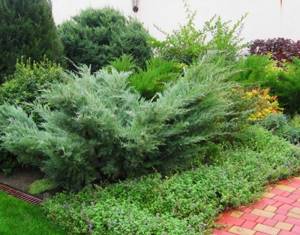
Hetz
Based on this species, many varieties have been bred, including hybrids. Among them, a popular variety - Hetz - was bred by crossing with junipers (Cossack and Chinese). The loose shape of the crown quickly forms a spreading bush (growth up to 30 cm per year). Good for pruning. In 10 years it grows up to 2 meters in height and about 3 meters in diameter. The needles are colored bluish-green, and in the first year of life they are scaly. With age, the needles become needle-like.
Frost-resistant and undemanding variety to soil, capable of growing in direct sunlight.
It will do best in moderately moist, light, well-drained soils with weak acidity. Perfect for hedges and rocky coniferous gardens.
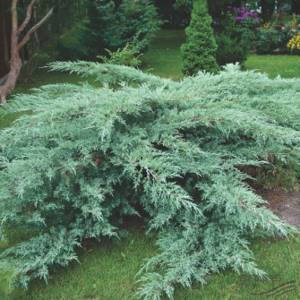
Gray Owl
Gray Owl is a hybrid that can grow up to 4 meters in diameter, forming a multi-tiered crown with age. The height of the bush rarely exceeds 1 meter. Upward branches bend with age. The needles are soft, gray-green in color, and hang down at the ends of the branches. Frost-resistant and drought-resistant species, in dry air it needs sprinkling.
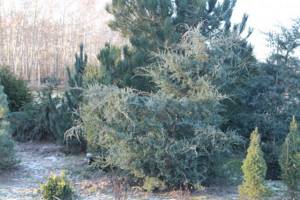
Glauca
The Glauca variety has a spreading crown (up to 2 meters in diameter) and is capable of growing up to 4 meters in 10 years. Older plants lose their attractiveness, however, if the plant is pruned, the decorative appearance can be preserved for several decades. The side shoots are thick, directed upward, forming a conical crown. Young needles are scaly, closer to the center the shape of the needles is needle-shaped. The silver-green color of the needles takes on a purple tint in winter.
The tree can withstand light shading, but in open space the shape of the crown and color will show up better.
Like all junipers, it easily tolerates drought and poor soils. Can be used as a tapeworm in garden plantings or as a hedge.
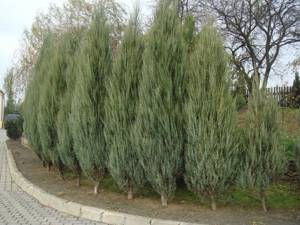
Skyrocket
Skyrocket virginiana - this variety differs from rock juniper in that it can grow in partial shade. Its needles are gray-green and turn brown in winter. The height of the plant is 5-8 meters and the width is up to 1 meter. The beautiful wedge-shaped shape becomes openwork and spreading with age. Prefers clay, loamy and sandy soils. Soft needles are not afraid of pruning, which allows this variety to be widely used in landscape design.
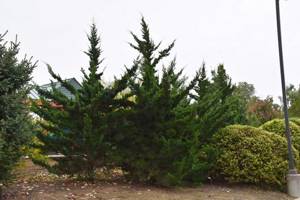
Canaertii
Canaertii is a variety with a loose crown: the branches pointing upwards diverge, forming a lush tree. An adult plant has a diameter of up to 1.5 meters. By the age of 10, the plant grows up to 4 meters. The tips of the branches are soft, hanging down, forming feathery brushes. The fruits are blue-green with a white, waxy coating. This is a heat-loving variety native to central and southern North America. In cold regions of Russia it needs shelter. Drought and polluted air in the city will not spoil it.

Golden Spring
Golden Spring is an interesting representative, obtained by crossing different species. The shape of the crown of a young bush tends upward, forming a funnel, and with age the branches droop and acquire a horizontal, outstretched direction of growth. An adult plant does not rise above 50 centimeters, but grows up to 1.5 meters in diameter. The needles are green, with a yellow-cream tint.
↑ Juniper horizontal
This species is represented by a shrub with creeping flexible shoots and a lot of small lateral branches. The needles have a bluish-green or green color. The type of needles are scales or needles that turn burgundy in color during the winter months. Based on the species, geneticists have developed 60 varieties.
↑ Variety Juniperus horizontalis
A shrub that spreads along the surface of the ground with long branches. The needles are found both in scaly form and in the form of needles. The fruits are black, spherical in shape.
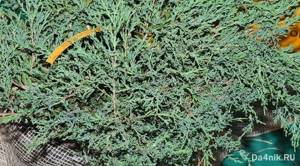
↑ Juniper Agnieszka
Dwarf bush from Poland. It does not grow higher than 30 cm, spreading out to the sides up to one and a half meters. The bluish-green needles are small, and after the first frost they turn lilac.

↑ Juniper Golden Carpet
The bushes grow very slowly, their height is only 10-20 cm, and their diameter is up to one meter. The needles are yellow in color and small in size, most often needle-shaped. The crown is flat, the side branches are shortened and directed upward.
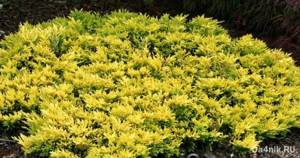
↑ Juniper horizontal Gray Pearl
The variety differs from others in its shoots, which reach 40 cm in height and grow vertically. It spreads on the ground up to 1.7 m. Coniferous paws are painted bronze in winter, bluish-gray during the rest of the year, sometimes the plant is found with blue-green needles.

↑ Juniper Icee Blue
The variety is dwarf, grows up to 10 cm, spreads over the surface up to 2 m. Coniferous paws of silver-blue color form a dense crown.
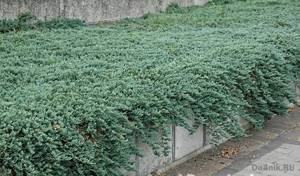
↑ Juniper Wiltonii
The plant covers any surface with a dense carpet, its height is up to 20 cm. The branches form a dense crown, and over time the branches are layered on top of each other. Type of needles: needles of a bluish-silver hue. The variety is very unpretentious, but the plant grows slowly! Many gardeners plant this juniper on the roof for landscaping.
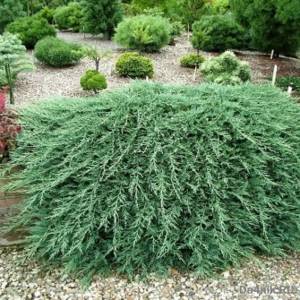
We recommend studying: the best frost-resistant ground cover perennials for your dacha
Planting and care
The key to successful planting is the correctly selected seedling. Plants take root well after 3-4 years of life in containers with a closed root system.
The correct planting material is when the soil is covered with moss and the roots do not yet emerge through the drainage hole.
This tree can be planted at any time of the year. The best time for planting is from April to May or October. At this time, the soil is moist enough to successfully root the plant. An open place will do.
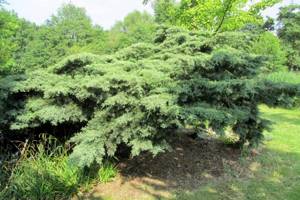
Landing rules
- Junipers do not like transplants, and can live in one place for up to 40 years. Therefore, you should immediately decide on a place.
- The landing site is well lit or slightly shaded.
- In two weeks, dig a hole up to 70 cm in diameter (if the plant is an adult). At least 20 centimeters of drainage (expanded clay, broken brick or gravel) is placed at the bottom. Fill the hole with fertile soil with sand in a 1:1 ratio and fertilizer for conifers.
- Within two weeks the soil sags and a tree can be planted there, sprinkled with soil and sand in the same ratio, but without fertilizer.
- The first two weeks after planting, the plant is watered regularly.
- In the first year of life in a new place, especially if the plant is young, shelter is necessary so that the branches do not break under the weight of the snow.
- Every year it is recommended to mulch the plant with peat or sawdust. The mulch layer can reach 8 centimeters.
Trimming
The first year after planting, cosmetic pruning is required. Some branches may turn yellow and dry out; they are removed. Juniperus virginiana responds very well to pruning, it can be given various shapes, the crown only becomes thicker. It is better to prune in the spring before active growth begins.
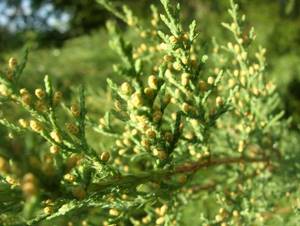
Juniper care
Juniper is a fairly unpretentious plant and does not require special care. The only thing that is extremely important for the Virginia species is insulation before frost, since it will not survive the cold season without human help.
Watering
Only young trees require watering, since all the work of the roots is aimed at growth . During the first two years, juniper needs to be watered at least once a week. During dry summers, the amount of watering needs to be increased. Mature trees do not need watering, except in hot summers when the ground is too dry. Two or three buckets over the summer will be enough.
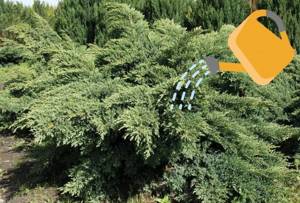
Top dressing
Feeding, as well as watering, is required exclusively for “young animals”. At the beginning of warming (end of March-mid-April), it’s time to comprehensively fertilize the root system . To do this, you need to purchase a special substrate for coniferous trees, pour it around the base of the plant and water it generously. This feeding is enough for a year. If the juniper grows normally and develops correctly, then after 3-4 years you can stop feeding.
Diseases and pests: treatment methods
Most often, junipers suffer from fungal diseases. A plant affected by rust begins to dry out, and thickenings appear on the branches. When ripening, the mushrooms cover the thickenings with mycelium, coloring them orange. This type of fungus requires two hosts, one of which can be an apple tree, pear tree or hawthorn. Another carrier is a conifer, such as juniper. You can save the plant by removing the affected branches with a sterile pruner and destroying them. The tool must be wiped with alcohol after use. Both fungal carriers must be treated with a fungicide.
The dry top of the tree indicates infection with fungi of the genus Fusarium. The tree's needles turn red, and the root system turns black: over time, gray spores form on it. The fungus from the root, through the vascular system, spreads throughout the plant, cutting off the supply of nutrients. The affected branches are removed “surgically” and the entire plant is treated with a fungicide. You can use Maxim, Topaz or Fitosporin. If possible, the soil under the plant must be replaced. But it is most likely impossible to save the plant; the damage comes from the root.
The cause of this disease is waterlogging of the soil. It is Virginia junipers that are more susceptible to this disease.
Schutte is a disease expressed in yellowing and falling of last year's needles. Dark ellipsoidal fruiting bodies are visible on the needles.
Coniferous plants suffer from infection by fungi of the group Cytospora pini, Hendersonia notha, Phomopsis juniperovora, Diplodia juniperi, Rhabdospora sabinae and Pythium cupressina. This manifests itself in the yellowing of individual branches. Then the area of the lesion increases and dark formations appear on the branches - fruiting bodies.
Before planting, it is better for the purchased plant to undergo preventive treatment with antifungal and antibacterial drugs.
It is almost impossible to save a sick plant; it can become a source of disease for the entire garden.
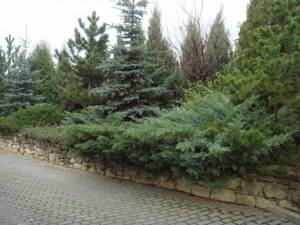
The following will help reduce the risk of infection:
- Preventive treatment with fungicides.
- Well drained soil.
- Planting thinning.
Much less often the following settle on juniper:
- Angular-winged pine moth
- cypress thicket
- juniper sawfly
- juniper scale insect
- spider mites.
Insects are visible to the naked eye. The insect development cycle has a stage when the larva is in the ground. When treating plants with insecticides, it is necessary to shed the soil and repeat the treatment within two weeks. Insects in the pupal stage are protected from the effects of the drug by a dense shell.
Preventative treatment in May and June will reduce the possibility of insects appearing.
For prevention, you can use the same drugs as when detecting pests. These could be: Profi, Aktelik, Fufanon or Decis.
Reproduction of Virginian juniper Juniperus Virginiana
Sometimes obtaining decorative forms of shrubs using seeds can be quite problematic. This is due to the fact that not all seeds can germinate.
Cuttings
Gardeners recommend using the option of propagating juniper virginiana by cuttings: in the spring they are cut 5–8 cm from the young shoots of the plant, each of them contains up to 2 internodes and a small fragment of the bark of the mother branch. The planting material must be pre-treated with a root formation stimulator.
Planting is done in soil mixed with peat, humus and sand in equal parts. The top of the soil is sprinkled with coarse sand up to 5 cm. A glass container is used as a cover for each cutting. The cuttings are planted to a depth of 1.5 - 2 cm.
The root system of the plant begins to develop in the fall, it is grown for another 1 - 1.5 years before transplanting to a permanent place.
From seeds
Before germinating the seeds of juniper virginiana shrubs, they must be treated with cold for a faster growth rate. The seeds are placed in boxes with soil mixture and taken outside for storage for up to 5 months. Seeds are sown in beds from May.
In some species of juniper virginiana, the seeds have a fairly dense shell. Their germination can be accelerated by exposing the shell to acid or by mechanically disrupting its structure. For example, they rub the seeds between two boards covered with sanding material, and then place them 3–4 cm deep in the ground. Caring for the crops is quite simple: you need to mulch the beds, provide regular watering and protection from active sun in the first one and a half to two weeks. When the seedlings are 3 years old, they are allowed to be transplanted to a permanent location.
How to propagate?
There are three ways to propagate juniper virginiana.
Propagation by seeds will produce a large number of healthy plants. Good seeds are found in dark colored fruits. To obtain seeds, ripe fruits are soaked and ground. The seeds are kept in a growth stimulator for 24 hours and another 30 minutes in a slightly acidic solution. Soil for coniferous plants can be purchased at the store and disinfected.
It is good to add soil from the place where junipers grow to the soil. In the ground there are symbiont mushrooms that are in “commonwealth” with coniferous trees and help in growth.
Seeds stored indoors require stratification, or they can be placed outside in a container, covered with spruce branches and snow. Young plants are in no hurry to appear; you may have to wait from 1 to 3 years. Young plants are planted in greenhouses or separate containers. Carefully monitor air and soil humidity. The plant can be planted in a permanent place at the age of three.
The second method of propagation is cuttings. Planting material is cut in February. You can plant cuttings before winter, but then they will have to be cut off in early June. This is necessary for the formation of roots: they will appear only in a month and the plant will need another two months to take root. But cuttings taken in early spring will take root and overwinter better.
How to take cuttings correctly?
- The cut must be made with a sterile instrument in cloudy weather or in the evening.
- Cut off the top green shoots. For representatives of horizontal varieties of Virginia juniper, these should be vertical shoots.
- The branches should be from 10 to 25 centimeters in length. The lower part of the trunk is cleared of pine needles and bark to 4 centimeters.
- The cuttings are planted in soil made of peat and humus to a depth of 2-3 centimeters. The distance between cuttings should be at least 50 centimeters.
- At the end of autumn, plants can be planted in a permanent place.
- The first year in a new place the plant requires watering and mulching. Shelter is required for the winter.
Reproduction by layering. This method is convenient only for creeping and horizontal varieties of Virginia juniper. To do this, the bush is watered abundantly and the soil is loosened. Add humus, peat, sand to the soil. The part of the trunk in the area of the internode is cleared of bark and pressed to the ground with pins. Layers are sprinkled with peat and humus on top.
Only next year, when the cuttings have their roots, can it be cut off from the mother plant.
There is another way to propagate rare species - grafting. A cutting of a rare species is grafted onto common juniper. This method does not allow you to get many plants and the survival rate is very low.
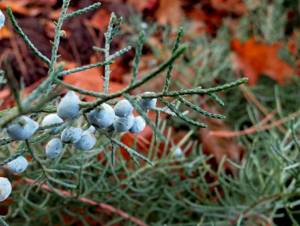
Recommendations for growing juniper virginiana "Hetz"
Caring for juniper virginiana Hetz will not require much effort if you correctly approach the issue of choosing a place to place it from the very beginning. The best option for growing this variety of juniper is light sandy loam soil of neutral or slightly alkaline composition. In conditions of high acidity of the soil, or on salty soils, the chances of success of the entire juniper growing project are significantly reduced. An important point is also the drainage of the site, since the root system of juniper bushes does not tolerate excess moisture in the soil very well. For the same reason, areas where groundwater comes close to the surface of the earth should be avoided.
Preparatory work for planting seedlings
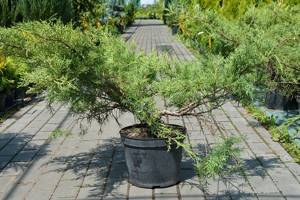
The primary task of a gardener who decides to plant Hetz juniper on his plot is to choose high-quality planting material. Only strong and healthy seedlings that have no traces of infections or mechanical damage are suitable for planting in open ground. The optimal age of a seedling is 2 years or a little older; adult plants are not suitable because they do not adapt well to a new place. A seedling suitable for planting must have smooth, intact olive-colored bark and already formed needles on the shoots. Its root system should also be sufficiently strong and healthy. It is best to purchase seedlings from large nurseries or from trusted sellers. Preference should be given to seedlings with a closed root system located in a container with a nutrient substrate.
If you purchase a seedling with an open root system, it is recommended to pre-treat it with a solution of potassium permanganate, and then place it in a root growth-stimulating liquid (Kornevin) for several hours.
Site preparation begins a week before the planned planting and consists of deep loosening the soil, as well as, if necessary, neutralizing its composition. Then planting holes are dug about 0.6 m deep, whose diameter should be almost twice the size of the earthen ball protecting the roots. To prevent stagnation of moisture, it is necessary to drain the planting holes by pouring a layer of broken brick, expanded clay and pebbles about 0.2 m thick on the bottom. On the eve of planting, it is recommended to generously spill the planting holes with water, filling them to the brim. If you plan to plant several juniper bushes, you must leave a gap of about 120 cm between the planting holes.
You can prepare a nutrient mixture for filling the holes yourself. To do this, mix humus, peat, sand and soil in equal parts.
Instructions for planting juniper seedlings in open ground
The step-by-step landing algorithm includes the following steps:
- The planting hole is half filled with nutrient soil mixture so that it takes the shape of a mound.
- A juniper seedling is placed on its top so that its root collar is level with the edges of the planting hole.
- The remaining space is filled layer by layer with soil mixture and compacted tightly.
- The last 10 cm are filled with moistened sawdust.
- The earth is compacted and abundantly moistened.
Fertilizer application and watering regime
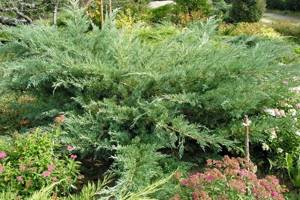
During the first 3 months after planting, young juniper bushes need daily moderate watering. The best time for this procedure is evening. To speed up the rooting of seedlings, you can add Kornevin to the water for irrigation, especially if the roots have not been pre-soaked in its solution. In the mornings, it is recommended to sprinkle with warm water. In the first years, Hetz juniper does not need fertilizers, since the substrate filling the planting hole provides the necessary amount of nutrients. Mature juniper bushes have a powerful root system, which, without the help of a gardener, is able to receive nutrition from the soil.
Rules for caring for the soil on a site with juniper
Mulching the soil around the juniper trunk will retain moisture and protect the roots of the young plant from overheating in summer and freezing in winter. In addition, a layer of mulch prevents weeds from germinating and taking away nutrition from the seedling. It is necessary to mulch the soil immediately after planting the seedling, using peat, sawdust, and dry leaves for this purpose. Before winter, it is recommended to increase the layer of mulch, and in the spring it is necessary to replace it with fresh one, since spores of pathogenic fungi and pest larvae can overwinter in it.
Loosening and weeding are necessary only for young juniper bushes, and these procedures should be carried out with extreme caution so as not to damage their root system. When the plant grows, its dense crown and the shadow it creates will protect it from weeds that simply cannot germinate in the tree trunk circle.
Sanitary and formative crown pruning
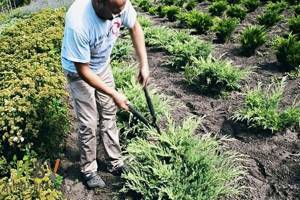
There are two types of juniper pruning: sanitary and formative. Young bushes under 2 years of age only need sanitary pruning, when all dry and damaged shoots are removed in the spring. Plant residues after this procedure should be burned. In the 4th year after transplantation, you can begin formative pruning.
The crown needs to be formed in the spring before the movement of plant juices in the tissues of juniper bushes begins.
Use in landscape design
Conifers occupy a special place in the garden. They allow you to create a flowerbed, the decorativeness of which is not lost with the change of seasons. Juniperus virginiana looks great both as a tapeworm and as a hedge. Some varieties do well in pots, forming a pointed crown (“arrowhead”), or forming dynamic cascades of greenery from low-growing varieties. Can be used in rockeries and alpine slides. The variety of shapes and colors will allow you to create a composition only from representatives of this species. But combined with contrasting foliage and perennial flowers it will look better.
Juniperus virginiana is an excellent species for sunny spaces, capable of maintaining decorative value for up to 40 years. According to some sources, it will not be able to overwinter at temperatures below 30 degrees and requires shelter. Otherwise, this is a beautiful tree with good decorative qualities and is a source of phytoncides.
Reproduction of juniper virginiana GreyOwl (Gray Owl)
Gray Owl can be propagated in 3 ways:
- cuttings;
- seeds;
- bends.
Propagation by seeds is a labor-intensive process, and not everyone can do it. Therefore, to propagate the variety, it is better to use other methods.
Cuttings are an easy and effective method of propagation.
- In August, lignified, young cuttings are cut.
- Harvesting is carried out in cloudy weather.
- The cut is made with a sharp, sterile instrument.
- The cuttings are treated with “Kornevin” or “Epin”.
- Prepared shoots are buried in nutrient soil, shed and put away in a warm place. The optimal temperature for rapid formation of the root system is 16-20 °C.
- After new foliage appears, the temperature is increased to 26 °C.
- Rooting cuttings are very demanding when it comes to watering, so spraying is carried out once a week.
- A new young plant is planted in a permanent place a year after the roots appear.
Reproduction by cuttings is the simplest method, which does not require additional effort and time.
- The soil around the bush is carefully loosened and fed.
- The lower shoot is cleared of needles, laid on the ground and secured with a metal bracket.
- The shoot is sprinkled with earth, watered and mulched.
- In the spring of next year, the rooted seedling is separated from the mother bush and transplanted to a prepared place.
